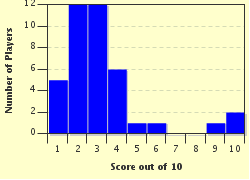Quiz Answer Key and Fun Facts
1. What approximate percentage of the German armed forces participated in Operation Barbarossa on 22nd June 1941?
2. The Red Army's victory in the Battle of Moscow 1941-1942 marked the first major German defeat in WW2 and shattered the myth of Wehrmacht's invincibility. In the end, what was the ultimate outcome of this major and great battle?
3. Which of these four was NOT a direct consequence of the catastrophic German and Axis defeat at Stalingrad in early 1943?
4. In the 1943 Battle of Kursk, aka 'the greatest tank battle in history', the Red Army decisively defeated the Wehrmacht, and that ultimately sealed the fate of Nazi Germany. Which one of these objects or subjects saw combat action for the first time in the Kursk bulge?
5. The Battle of the Dnieper River in the autumn of 1943, which subsequently led to the liberation of left-bank Ukraine, was one of the largest and most costly operations in history of warfare. For what feature is this battle known for from Red Army's side?
6. The Red Army's successful Dnieper-Carpathian Strategic Offensive Operation, which was divided into smaller operations and conducted in January-April 1944, was a direct successor to the successful Battle of the Dnieper. Which one of these Red Army offensives reached Romania, split Wehrmacht's Army Group South into two and led to Erich Von Manstein's dismissal?
7. Which one of these battles is generally considered to be the biggest German military defeat in history?
8. The year 1944 is known as "Stalin's Ten Blows", during which the Red Army made great advances along the entire 2000+ km front, inflicting over 2 million casualties on the Wehrmacht compared to less than 600,000 in the West. Which one of these four was NOT a factor in the great Red Army advances of 1944?
9. Which one of these offensive operations was the final operation that the Red Army conducted against the Wehrmacht?
10. The Eastern Front and the Soviet Union played the single most decisive role in defeating Nazi Germany and its Axis allies. What percentage of the Wehrmacht perished on the Eastern Front against the Red Army?
Source: Author
Uspech3da
This quiz was reviewed by FunTrivia editor
bloomsby before going online.
Any errors found in FunTrivia content are routinely corrected through our feedback system.

